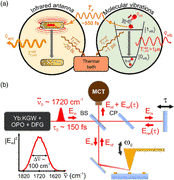Purcell-enhanced spontaneous emission of molecular vibrations
| Reviews and Highlights | Quantum Science | Molecular and Soft-matter | Ultrafast Nano-optics and Nanophotonics | Mineralogy and Geochemistry |
|---|
Bernd Metzger, Eric Muller, Jun Nishida, Benjamin Pollard, Mario Hentschel, and Markus B. Raschke
Phys. Rev. Lett. 123, 153001 (2019).
DOI PDF SI

Infrared (IR) spectroscopy of molecular vibrations provides insight into molecular structure, coupling, and dynamics. However, picosecond scale intermolecular and intramolecular many-body interactions, nonradiative relaxation, absorption, and thermalization typically dominate over IR spontaneous emission. We demonstrate how coupling to a resonant IR antenna can enhance spontaneous emission of molecular vibratio{“type”:”block”,”srcIndex”:4,”srcClientId”:”96a65832-8136-4cf1-bbbf-9949686d1837″,”srcRootClientId”:””}ns. Using time-domain nanoprobe spectroscopy we observe an up to 50% decrease in vibrational dephasing time T2,vib, based on the coupling-induced population decay with Tκ≃550fs and an associated Purcell factor of >106. This rate enhancement of the spontaneous emission of antenna-coupled molecular vibrations opens new avenues for IR coherent control, quantum information processing, and quantum chemistry.
